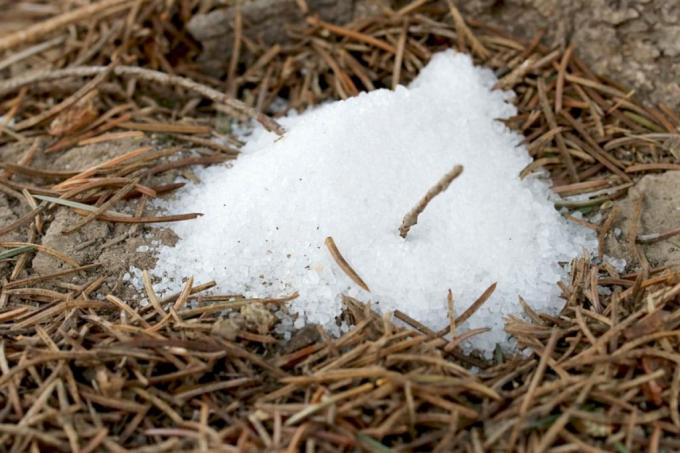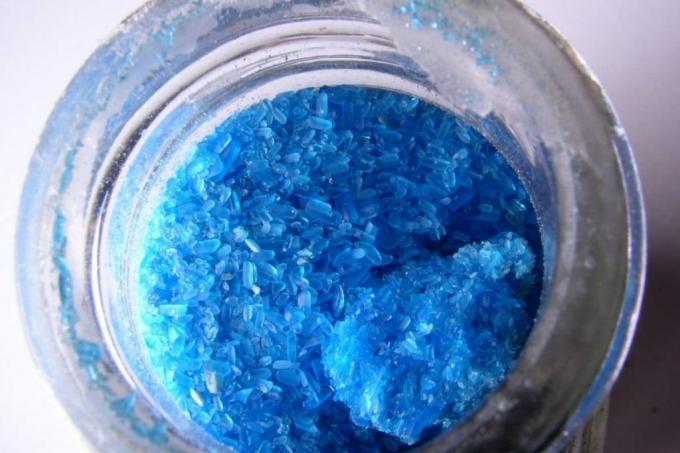
table of contents
- General remark
- Creepers and other parasites
- The ringing
- Epsom salt
- Copper sulfate
- Other toxins
- Copper nails and blue water nails
- frequently asked Questions
Although in principle every tree has a right to exist, it may be necessary to remove it in individual cases. Instead of the saw, you can tolerate it to die off using tree killers.
In a nutshell
- not all trees should be killed just like that
- Ringling is one of the most effective and at the same time most environmentally friendly methods
- many tree killers also damage other plants and even animals
General remark
Basically, we advise against removing a tree on your own responsibility, let alone poisoning it. In many federal states and municipalities, this is even prohibited by law. However, should a tree have to be removed because it is z. B. is sick or poses a danger in its location, contact a specialist whether and how the tree needs to be removed. Whenever substances are used, care must always be taken to ensure that the environment is not harmed.
This guide is for informational purposes only and does not constitute instructions!
Creepers and other parasites
Many trees die because they are literally turned off the sap by climbing plants and other parasites. If you have a lot of time and are looking for a particularly "natural" method of killing a tree, you should therefore target or specifically target these plants. to settle on it.

How does it work?
Climbing plants deprive the tree of light and air and impair its growth. Mistletoes, for example, attack the supply lines and damage the host from within. As a result, the load on the tree increases to the point of overload - it begins to die.
How long does it take
- approx. 12 to 24 months
particularities
- no real guarantee of success
- well suited to kill already damaged trees
- completely environmentally friendly variant
The ringing
One of the simplest and most effective methods is the so-called ringing. In addition, it works completely without any substances that could unintentionally damage other plants or even animals.

How does it work?
The cambium under the bark carries water and nutrients from the roots to the shoots and leaves. If it is removed, there is no supply and the tree gradually dies.
How long does it take
- approx. 12 to 36 months
particularities
- done correctly, very safe and reliable
- very slow method
- completely free of chemistry
Epsom salt
Magnesium sulfate, also called Epsom salt in everyday parlance, is used for a wide range of tasks, from laxatives to Plant fertilizer used. However, if overdosed, it can also be used effectively as a tree killer.

How does it work?
Magnesium sulphate develops a strong osmotic reaction in the wood, especially in the root area, as a result of which the cells drain and die. The tree's nutrient balance comes to a standstill.
How long does it take
- a few weeks to half a year
particularities
- often multiple refills of salt are necessary, as complete tightness of the sealed holes can hardly be achieved
- Magnesium sulfate in high doses dangerous for small mammals or plants in the immediate vicinity
- Means easily and problem-free available in the drugstore
Note: Even small cracks can allow saline solution to escape. If you do not notice any visible success, refill salt and water after a few weeks.
Copper sulfate
One reads again and again about the effectiveness of copper as a tree killer. This is indeed the case, but only works if the salt is used in high doses. Proceed in the same way as already described for magnesium sulphate. Effect and duration of action are generally comparable, with copper sulfate having an even more harmful effect on the surrounding flora and fauna.

Other toxins
In addition, there are numerous other harmful substances that can be used as tree killers, all of which are used in the same way as Epsom salt and copper sulfate. The substances are transported directly into the tree via bores, where they can then work precisely and effectively. For example, the following are well suited:
- glyphosate
- Other broad spectrum herbicides
- Acids (Caution: only use protective equipment!), E.g. B. Hydrochloric acid, battery acid etc.
Attention: Many substances that are very effective as tree killers are considered environmental toxins! If at all, they should therefore only be used in a limited manner and sparingly!
Copper nails and blue water nails
One reads again and again that even simple copper nails are sufficient to reliably let a tree die. However, reality shows that nails alone are not enough to destroy trees. It is true that they also release copper ions and damage the wood in the area of the point of impact. However, the amount is never sufficient for an effect beyond the impact channel.

Instead, the trade offers so-called blue water nails. These are also copper nails, but they are stored in a supplementary solution of copper oxide and are used together with this in bores. The main effect here is likely to come from the already treated copper oxide, so that the additional nail should in all probability be dispensable.
frequently asked Questions
Yes. Many regions or municipalities have so-called tree protection statutes. You regulate which resp. From what size trees can only be removed with permission. However, the contents of the statutes vary significantly.
Depending on the tree protection statute, fines of up to the middle five-digit range can be incurred. In addition, violations of the Nature Conservation Act very quickly reach the area of a criminal offense.
Questions about removing trees are usually answered by the local public order office or the nature conservation office in the responsible district office.
If you saw down a healthy tree, you will also meet numerous inhabitants of this habitat. If, on the other hand, it slowly dies, the animals gradually leave the plant and are no longer disturbed by the subsequent felling. In addition, felling is not always allowed, so that “killing” in advance brings some advantages in terms of admissibility.

